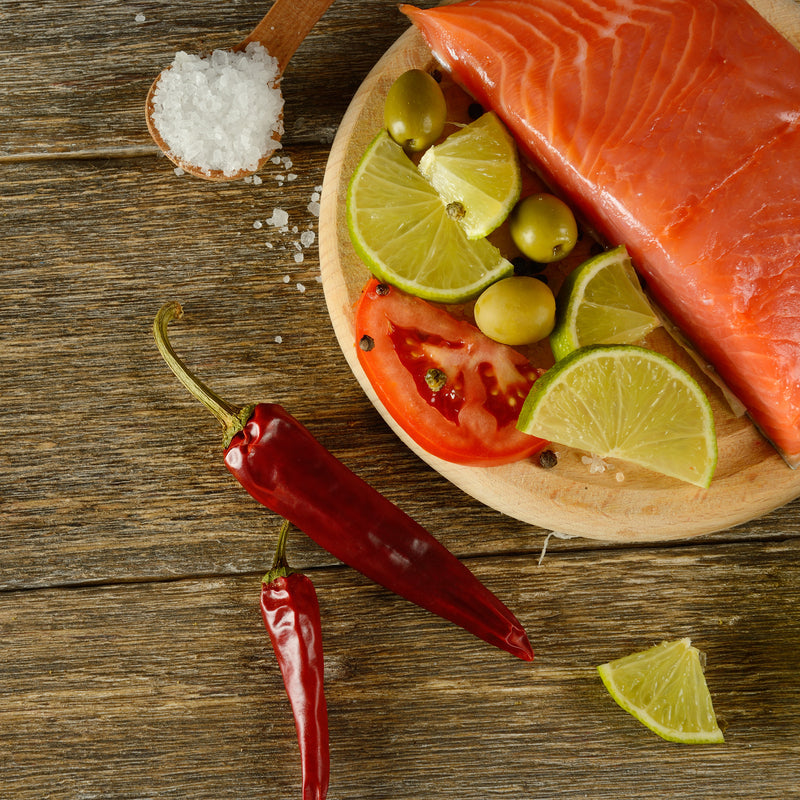Sockeye Salmon Habitat and Distribution: Where Do They Live?

Habitat and Distribution Sockeye Salmon Live
Sockeye salmon (Oncorhynchus nerka), known for their vibrant red color and exceptional taste, are a vital species in the North Pacific ecosystem. Their habitat and distribution span diverse environments, from Alaska’s pristine rivers to Russia’s untamed wilderness. Understanding where sockeye salmon live is key to appreciating their ecological importance and ensuring their sustainable future.
Discover premium sockeye salmon and explore our extensive selection of seafood products at Global Seafoods. For educational content, visit our YouTube channel.
Introduction: Where Do Sockeye Salmon Live?
Sockeye salmon are anadromous fish, migrating between freshwater and saltwater during their life cycle. This adaptability allows them to thrive across a vast range, from rivers in Alaska and Canada to Russia’s Kamchatka Peninsula and the Pacific Ocean.
"Sockeye salmon connect ecosystems and cultures, supporting life from the ocean to the forest," says Dr. Daniel Schindler, a renowned ecologist studying salmon in the Pacific Northwest.
To experience the best sockeye salmon, explore the Salmon Collection at Global Seafoods.
Geographic Range of Sockeye Salmon
Sockeye salmon inhabit two major environments: freshwater for spawning and rearing, and saltwater for adult growth and feeding.
1. Freshwater Habitats: The Cradle of Sockeye Salmon
Sockeye salmon begin their lives in freshwater streams, rivers, and lakes, where they also return to spawn and complete their life cycle.
Key Freshwater Locations
- Alaska: Bristol Bay, Copper River, and the Kenai River are global hotspots for sockeye salmon runs.
- Russia: The Kamchatka Peninsula and the Amur River are critical spawning grounds.
- Canada: The Fraser River in British Columbia is one of the largest sockeye salmon habitats.
Freshwater Habitat Features
- Temperature: Cold, oxygen-rich waters are crucial for egg development and fry survival.
- Gravel Beds: Provide protection for eggs and allow oxygenated water to flow through.
Explore Related Products
2. Marine Habitats: Where Sockeye Salmon Mature
After spending up to a year in freshwater, sockeye salmon migrate to the Pacific Ocean, where they grow and mature.
Ocean Distribution
- Eastern Pacific: From Alaska to Washington State, including British Columbia.
- Western Pacific: Coastal waters off Russia and Japan.
Marine Preferences
- Diet: Zooplankton, krill, and small fish, which contribute to their rich red color.
- Depth: Sockeye generally inhabit surface waters but can dive deeper in search of food.
Marine Conservation
Sustainable fishing and habitat protection ensure healthy sockeye populations in the ocean.
Habitat Hotspots for Sockeye Salmon
Alaska: A Global Sockeye Salmon Powerhouse
Alaska is home to some of the most productive sockeye salmon habitats in the world.
Bristol Bay
- The largest sockeye salmon run globally, producing tens of millions of fish annually.
- Conservation measures make it a model for sustainable fisheries.
Copper River
- Famous for high-quality salmon with a rich flavor and firm texture.
- Products to Try:
Russia: Untouched and Abundant
Russia’s Kamchatka Peninsula rivals Alaska as a critical habitat for sockeye salmon.
Kamchatka Peninsula
- Supports large populations of wild sockeye in pristine rivers and streams.
Amur River Basin
- A smaller but significant habitat near the Russia-China border.
Explore Related Products
Threats to Sockeye Salmon Habitats
Sockeye salmon habitats face numerous threats that can impact their populations.
1. Climate Change
- Warmer water temperatures can reduce oxygen levels and disrupt spawning.
2. Habitat Loss
- Dams and urban development restrict access to spawning grounds.
3. Overfishing
- Unsustainable practices threaten populations, particularly in regions with lax regulations.
Support Sustainable Fishing
Purchase responsibly sourced salmon at Global Seafoods.
Why Are Sockeye Salmon Habitats Important?
Sockeye salmon habitats are vital for:
- Ecosystems: Salmon transport nutrients from the ocean to freshwater ecosystems.
- Biodiversity: They are a food source for species like bears, eagles, and aquatic insects.
- Human Communities: Salmon support indigenous cultures and global seafood markets.
FAQs About Sockeye Salmon Habitats
1. Where do sockeye salmon live?
They live in the North Pacific Ocean and its freshwater tributaries, including rivers in Alaska, Canada, and Russia.
2. Why do sockeye salmon migrate?
They migrate to reproduce in freshwater where they were born, completing their life cycle.
3. What do sockeye salmon eat?
In the ocean, they feed on zooplankton, krill, and small fish. In freshwater, juveniles eat plankton and insects.
4. Are sockeye salmon endangered?
Some populations face threats from habitat loss and climate change, but conservation efforts are helping.
5. How can I support sockeye salmon conservation?
Buy sustainably sourced products, such as those from Global Seafoods.
Conclusion: Protecting Sockeye Salmon Habitats
Sockeye salmon habitats are integral to ecosystems, economies, and cultures. From Alaska’s Copper River to Russia’s Kamchatka Peninsula, these habitats sustain life and connect the ocean to the land.
For premium sockeye salmon, visit Global Seafoods. Watch our YouTube channel to learn more about seafood and sustainable practices.
Would you like additional SEO optimization or another article on related topics? Let me know!
Also in News

How to Make Sea Bream Sushi With Dry-Aged Tuna & Crab Roll — Step-by-Step With Chef Joshua
A complete guide to making Sea Bream sushi at home, including filleting, curing, slicing, and building a Dry-Aged Tuna & Crab sushi roll. Chef Joshua shares professional tips for restaurant-quality results.

Boiled Crab for Game Night: Everything You Need for a Perfect Seafood Party
Take your game night to the next level with a Boiled crab party. Learn the best recipes, cooking tips, and hosting hacks for a memorable seafood feast.

Boiled Crab for Date Night: A Romantic Guide to the Perfect Seafood Feast
Make your next date night unforgettable with a romantic Boiled crab experience. This guide covers everything you need to know, from ambiance to the best crab varieties.
